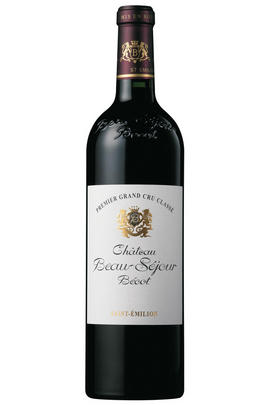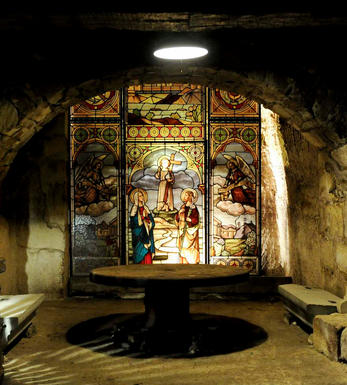
2010 Château Beau-Séjour Bécot, St Emilion, Bordeaux

Critics reviews
Robert M. Parker, Jr. - 28/02/2013
(Jancis Robinson MW- jancis robinson.com Apr 2011)
(James Molesworth – The Wine Spectator – Top Scoring Bordeaux 2010 – Mar 2011)
(93+ Robert Parker- Wine Advocate- Feb 2013)
Tiny yields of 21 hectoliters per hectare produced a wine with 15% natural alcohol. The final blend was 73% Merlot, 23% Cabernet Franc and 4% Cabernet Sauvignon. Quite backward, as if malolactic fermentation had just finished, this opaque purple-hued, large-scaled, massive effort reveals high tannins, high extraction and huge concentration. Everything is present, but this wine looks set for a long life and will not be as sumptuous or opulent in its youth as the 2009 or 2008. Forget it for 5-8 years and drink it over the following three decades.
(91-93+ Robert Parker- Wine Advocate- May 2011)
About this WINE

Château Beau-Séjour Bécot
Château Beau-Séjour Bécot has experienced some dramatic ups and downs in recent decades: it was classified a Premier Grand Cru Classé B in 1955, demoted in 1986 and promoted once again, as a Premier Grand Cru Classé B, in 1996.
The terroir is outstanding, most of it atop the limestone plateau. Juliette Bécot and husband Julien Barthe represent the third generation of Juliette’s family here, along with her cousins Pierre and Caroline Bécot. Not so long ago, the wines were turbo-charged and Parker-friendly, ripe with lots of new oak and extraction. Under Juliette and Julien’s guidance, there has been a major turnaround stylistically. Thomas Duclos consults here, having taken over from Michel Rolland.

St Émilion
St Émilion is one of Bordeaux's largest producing appellations, producing more wine than Listrac, Moulis, St Estèphe, Pauillac, St Julien and Margaux put together. St Emilion has been producing wine for longer than the Médoc but its lack of accessibility to Bordeaux's port and market-restricted exports to mainland Europe meant the region initially did not enjoy the commercial success that funded the great châteaux of the Left Bank.
St Émilion itself is the prettiest of Bordeaux's wine towns, perched on top of the steep limestone slopes upon which many of the region's finest vineyards are situated. However, more than half of the appellation's vineyards lie on the plain between the town and the Dordogne River on sandy, alluvial soils with a sprinkling of gravel.
Further diversity is added by a small, complex gravel bed to the north-east of the region on the border with Pomerol. Atypically for St Émilion, this allows Cabernet Franc and, to a lesser extent, Cabernet Sauvignon to prosper and defines the personality of the great wines such as Ch. Cheval Blanc.
In the early 1990s there was an explosion of experimentation and evolution, leading to the rise of the garagistes, producers of deeply-concentrated wines made in very small quantities and offered at high prices. The appellation is also surrounded by four satellite appellations, Montagne, Lussac, Puisseguin and St. Georges, which enjoy a family similarity but not the complexity of the best wines.
St Émilion was first officially classified in 1954, and is the most meritocratic classification system in Bordeaux, as it is regularly amended. The most recent revision of the classification was in 2012

Merlot
The most widely planted grape in Bordeaux and a grape that has been on a relentless expansion drive throughout the world in the last decade. Merlot is adaptable to most soils and is relatively simple to cultivate. It is a vigorous naturally high yielding grape that requires savage pruning - over-cropped Merlot-based wines are dilute and bland. It is also vital to pick at optimum ripeness as Merlot can quickly lose its varietal characteristics if harvested overripe.
In St.Emilion and Pomerol it withstands the moist clay rich soils far better than Cabernet grapes, and at it best produces opulently rich, plummy clarets with succulent fruitcake-like nuances. Le Pin, Pétrus and Clinet are examples of hedonistically rich Merlot wines at their very best. It also plays a key supporting role in filling out the middle palate of the Cabernet-dominated wines of the Médoc and Graves.
Merlot is now grown in virtually all wine growing countries and is particularly successful in California, Chile and Northern Italy.


Buying options
Add to wishlist
Description
A blend of 70% Merlot, 24% Cabernet Franc and 6% Cabernet Sauvignon, this wine from a moderately sized vineyard was cropped at only 27.5 hectoliters per hectare and came in at 14.5% natural alcohol. The wine displays plenty of toasty oak and vanillin as well as some lead pencil shavings intermixed with cedar, black currants, cherry jam, chocolate and espresso. It is a relatively big, dense, full-bodied St.-Emilion that needs 5-6 years of cellaring and that should keep well for up to two decades.
Robert M. Parker, Jr. - 28/02/2013
wine at a glance
Delivery and quality guarantee